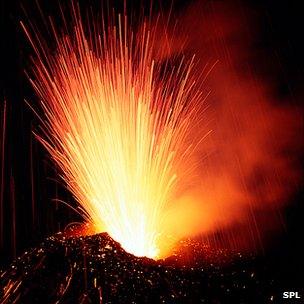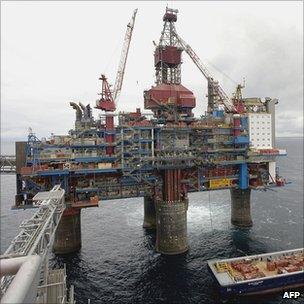Carbon capture is 'safe' - but how attractive?
- Published
- comments

The process that keeps Italy's volcanoes rumbling also releases CO2 across the country
How do you fancy living near a fissure in the Earth that keeps releasing carbon dioxide?
It's a question few of us might have considered in the past; but we may have to in future, if the vision of those in the carbon capture and storage, external (CCS) lobby comes to fruition.
According to a paper in Proceedings of the National Academy of Sciences (PNAS), external this week, it's not a problem that should keep us awake at night.
We've become familiar in recent years with having natural carbon dioxide "seeps" used as "natural laboratories", external for exploring ocean acidification, with Italian waters proving the first example.
And a different set of Italian CO2 seeps, on land this time, provides the location for the CCS research.
Across the nation, predominantly on the western side, nearly 300 holes and fissures are releasing the gas, a relic of volcanic rocks deep underground.
And a group of scientists at the National Institute of Geophysics and Volcanology (INGV) keeps a record of them, external.
Occasionally, the gas causes a death - 19 humans have suffocated this way over the last 50 years, as well as animals from cows to toads.
There's nothing on the scale of the Lake Nyos disaster, external in Cameroon in 1986, when a sudden release of CO2 from the deep waters killed an estimated 1,700 villagers as they slept.
The latest research saw academics at Edinburgh University's CCS unit, external go through the statistics on seeps and deaths.
And they reckon that the odds of being killed by a CO2 release are pretty acceptable - 10,000 times lower, for example, than your chances of dying in a car accident in Italy, and 1,000 times lower than the risk of being fatally struck by lightning in the US.
The leader of the research group, Stuart Haszeldine, said he decided to do this work because when he speaks about CCS at public meetings, this is something that people ask about.
Scottish authorities and Scottish companies see a lot of potential for CCS, not least because decades of North Sea oil and gas extraction have left it with a lot of relevant engineering expertise, a lot of pipes and other gear that could easily be adapted to carry CO2 to wells rather than natural gas from them, and a lot of holes in the seabed that could make good storage sites.

The Norwegian Sleipner Field project shows economic levers can work.. if they are put in place
It's likely that Longannet coal-fired power station, external just north of Edinburgh will become one of the first in Europe to have its flue gases cleansed of CO2, the gas pumped a few hundred miles north for disposal.
To aid in research that might pave the way for all this, a number of companies including Shell, BP, E.On, Arup and Schlumberger have come together in the Scottish Carbon Capture and Storage consortium, external.
It funded the Edinburgh study; and another consortium member, Scottish Power, funds Stuart Haszeldine's professorship.
He told me that the university accepts funds on the basis that the companies involved have no say in what research is done; and as all the data is in the public domain thanks to the Italian registry, anyone could go through the numbers and check the stats.
It's interesting that people are bringing up this question in public; but it has to be said that as things stand, public acceptance isn't the main obstacle to the wider deployment of CCS.
The obstacle is basically money.
Capturing carbon dioxide from the tail of a power station means you have to burn more coal, produce more energy, and so spend more money.
Currently, the best pilot projects around Europe are paying an "energy penalty" of 15-20%, Professor Haszeldine said - better than a few years ago, but still something that no company is going to do voluntarily unless there's another component to the argument.
Power companies could be induced to implement CCS by a high carbon price.
They could be forced to by legislation, as is theoretically the case in the UK.
Or they could make money from it.
The Scottish consortium website has a great interactive map, external giving locations and a few details about CCS projects around the world.
Unsurprisingly, they're mostly in Europe and North America, with some interest from East Asia and Australia.
Clicking through the ones that are actually in operation gives you insights into what's behind the big projects that are actually up and running - and into another environmental problem that their existence creates.
Virtually all of them (and there aren't that many) exist because the gas is being used for enhanced oil recovery (EOR).
Pumping gas down into the oil-bearing rock means that more of the oil can be brought to the surface.
In the case of the North American Weyburn-Midale Project, external, it's expected to prolong the productive life of the oilfield by 25 years... meaning an extra 25 years of burning that oil, producing carbon dioxide emissions - and all from a technology that's designed to reduce emissions.
CO2 doesn't have to be used for EOR; as the Norwegian Sleipner Field project demonstrates, external, if governments put the right legislative and economic instruments in place, the gas can just disappear underground (or under the seabed) more or less for ever.
Whether this will ever happen on a wide enough scale is pretty much the only question that matters in this arena; and so far, there's little evidence of an affirmative answer.